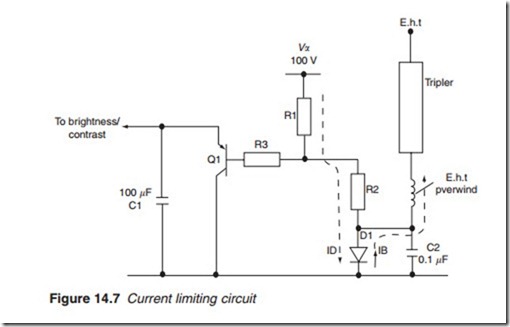Beam limiting
CRT-type TV receivers employ some form of beam current limiting to ensure the electron emission (beam current), hence the brightness does not exceed a pre-determined limit. Beam limiting is optional for monochrome TVs but essential for colour TVs. A very high beam current overloads the line output amplifier and the extra high tension (e.h.t.) tripper, causing deterioration in focus; it overdrives the c.r.t., causing limited highlights; and it leads to excessive power dissipation in the mask within the tube, which may cause misconvergence of the three primary colours on the screen. Beam limiting involves sampling or monitoring the strength of the beam current directly at the cathode, or indirectly by monitoring the d.c. current taken at the line output stage or the e.h.t. winding. The beam current itself is then controlled by reducing the black level (i.e. the brightness) or the amplitude of the luminance signal (i.e. the contrast) or both.
Figure 14.7 shows a circuit of a typical beam limiter arrangement used in colour TV receivers; the e.h.t. current is monitored by a diode D1 placed between the earthy end of the e.h.t. overwind and chassis. Two types of current flow through D1: forward current ID of about 600 f.A to chassis, caused by voltage Vcc, and beam current IB flowing in the opposite direc- tion. When the beam current goes above 600 f.A, D1 switches off and its
anode goes negative; this reduces the base voltage of emitter follower TR1, hence it varies the brightness/contrast controls. For larger tubes, the pre- set beam current limiting is raised to 1 mA. Decoupling is carried out by C1 and C2.
